When you stand on the side of the road, gathering your courage to cross a dense sea of motorbikes, crossing the entire country might seem like a crazy idea. But anyone with a little know-how can do it. Bikes are an essential part of the Vietnamese lifestyle, and you should not ditch it. So here’s a short guide to experience Vietnam like it should be and live to tell the tale.
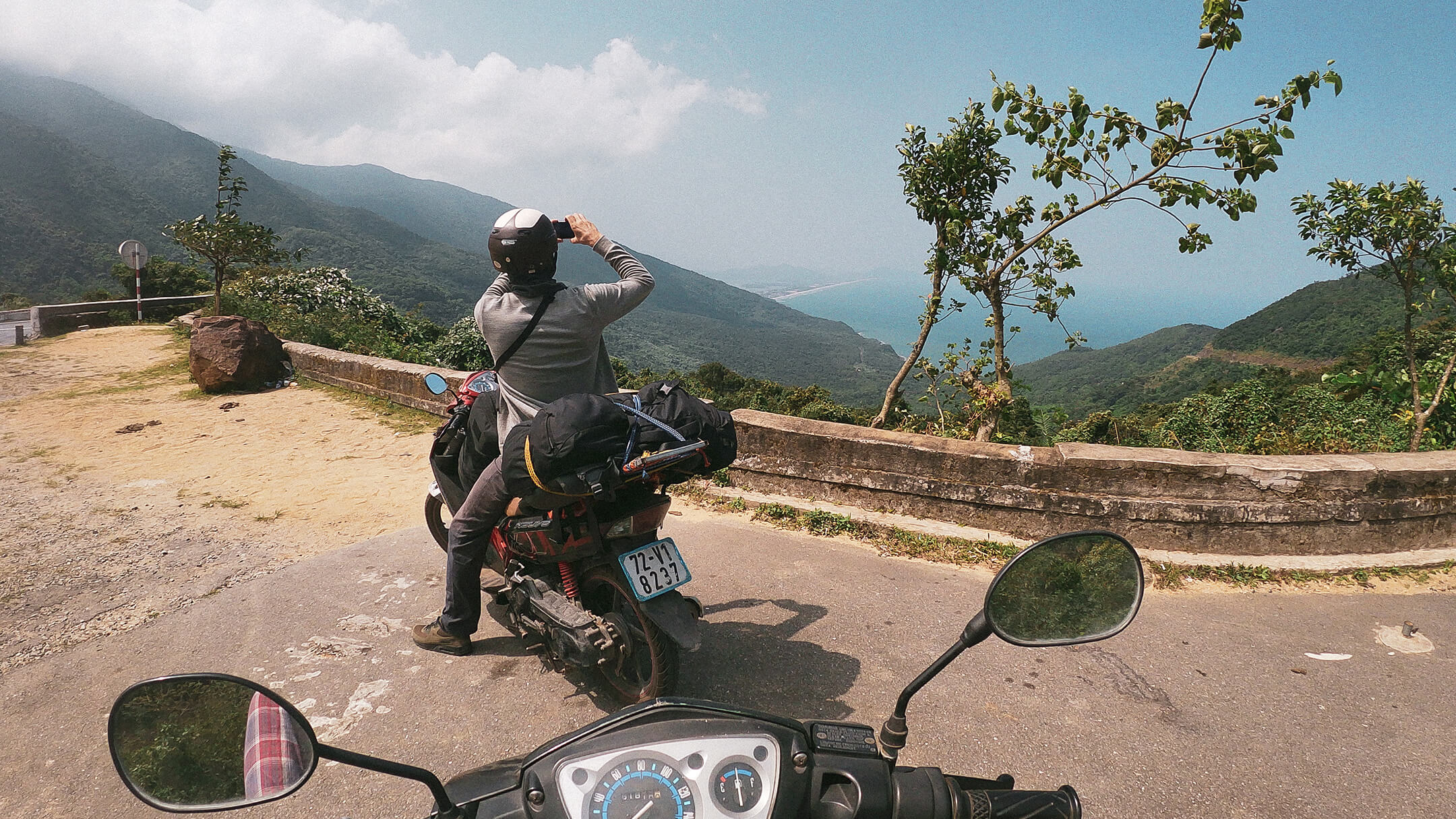
The basics
- 🏛 The legal stuff
- 🛵 Choosing a ride
- 💵 Rent or buy?
- 🧤 Gear up!
- 🔧 Taking care of your ride
- 💰 How much does it cost?
Living on the road
- 🚦 The traffic
- 🛣 The state of the roads
- 🛏 Where to sleep
- 🍚 How to eat
- ⛽️ Fill your tank
- 🗺 Navigation tips
- ⛈ Weather precautions
Good to know
- 🚔 The police
- 💥 In case of accident
- ⛔️ A parking religion
- 🔒 The risk of theft
- 💀 The dark side of the road
Disclaimer
Driving is dangerous. You can die, kill, be wounded or seriously arm others. In Vietnam this is even more likely. The road claims around 40 lives everyday. If you cause an accident you risk 30 years in Vietnamese jail, if you die it is permanent. No guts no glory. You've been warned.
I. The basics
The legal stuff
The vast majority of foreigners in Vietnam drive illegally. As of today, only Vietnamese driving license is recognised, and it is not possible to get it with a tourist visa. You need a business visa, a working permit or residency.
On the internet, I have read many contradictory things about the international driving permit. Only countries using the 1968 convention are recognised in Vietnam. UK, USA, Australia are on the 1949 convention. If your country is on the right IDP convention, you can drive legally (if you have a motorbike license).
If you do have a valid license, you will need an insurance. There is no real third party insurance in Vietnam, so you will need an insurance from home. Many insurances and travel insurances are very specific about driving a motorbike in South East Asia : fuck no! Anyway, without a valid permit, you do not exist for insurances. If things go sideways, you are on your own.
We do not encourage illegality, but the world is not just the western world. In Vietnam things are not so strict, the proportion of insured drivers, or drivers with a permit is probably not 100%. It's not rare to see 5 people on one bike, no helmet, passing a red light while on the phone.
So most travellers don't bother about insurances, or even having a driving license in their home country. This is Vietnam here, and you probably came for a little adventure, otherwise you would have picked Germany.
Choosing a ride
There are many types of bike in Vietnam. Automatic scooters (Honda Airblade, Yamaha Nouvo), Manual scooters (Honda Wave), The Win type, dirt bikes, and everything in between. The engines are mostly around 100cc. Whatever you get, make sure it's not a collection of loose parts. Quality is not always given, and this can turn costly or dangerous.
Make sure the bike has a rack to carry your stuff. If not, you can get on at the nearest garage.
Dirt bikes
If you have money to spend, go for them. The Honda XR150 is widely seen as the best bike you can get in Vietnam. Because it is reliable, and will handle the worst roads of Vietnam, it's worth the money — somewhere around 3000€
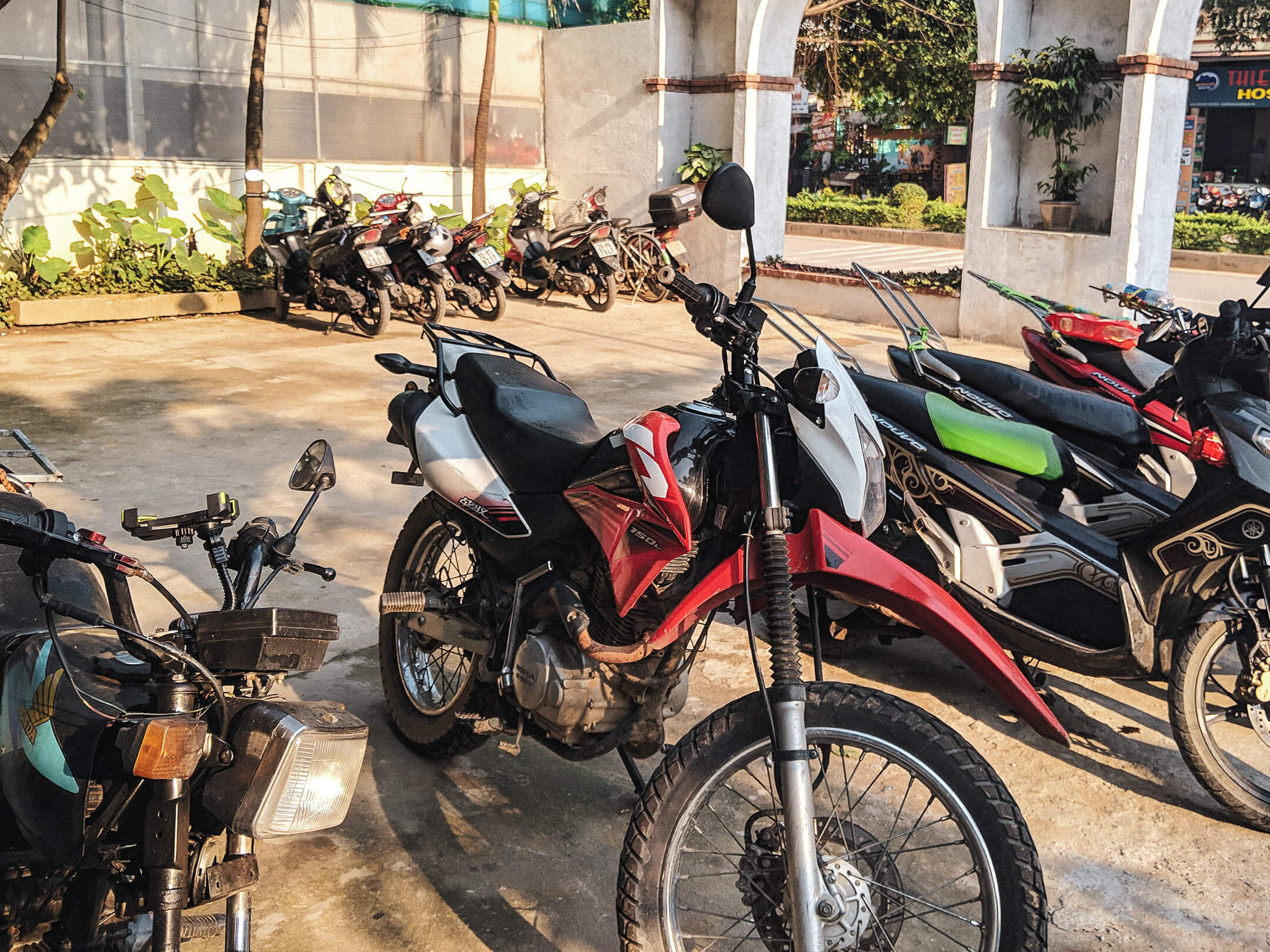
The Wins
Most riders go for the Honda Win or its various copies. It's an iconic bike, praised amongst backpackers. They are as close as you can get to a real motorbike, and they look really cool. The downside is their unreliability. You often get Chinese copies, maintained with poor quality aftermarket parts. You rarely see locals driving them, except up in the mountains. If you're more about Instagram likes and street credibility, get your hands on a decent one for about 400€.
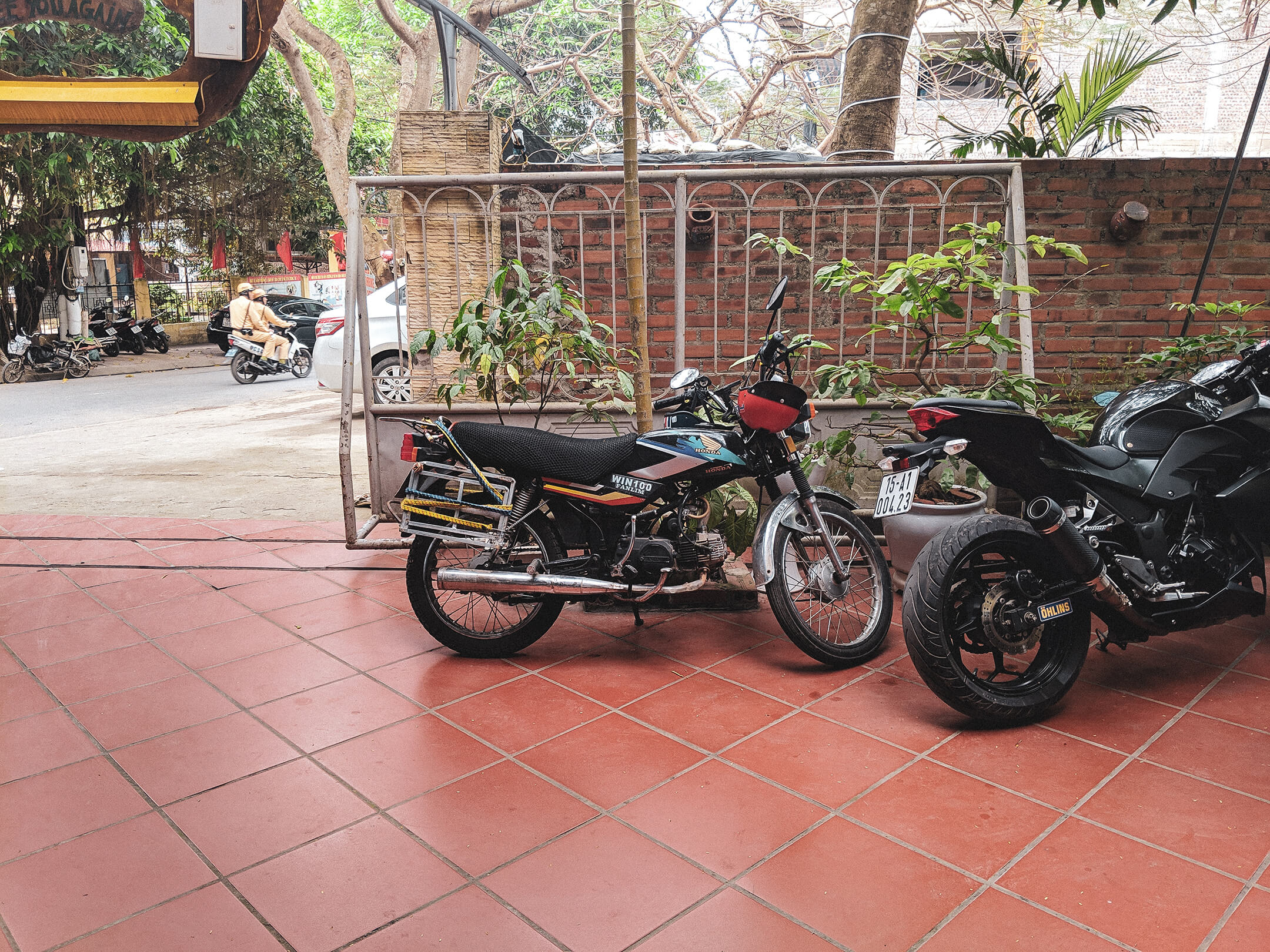
Automatics/manual scooters
Probably a little less fun, but more reliable, they will cost you around 200€. Big wheels assure a good handling, they can haul a lot of stuff and reach a decent speed. They are the most common vehicle in Asia. Get about 60 km of relative comfort before you lose all sensitivity in your lower body. Make sure you get one with the petrol trap outside of the seat storage so you don't need to take away the backpacks every time we needed a refill.
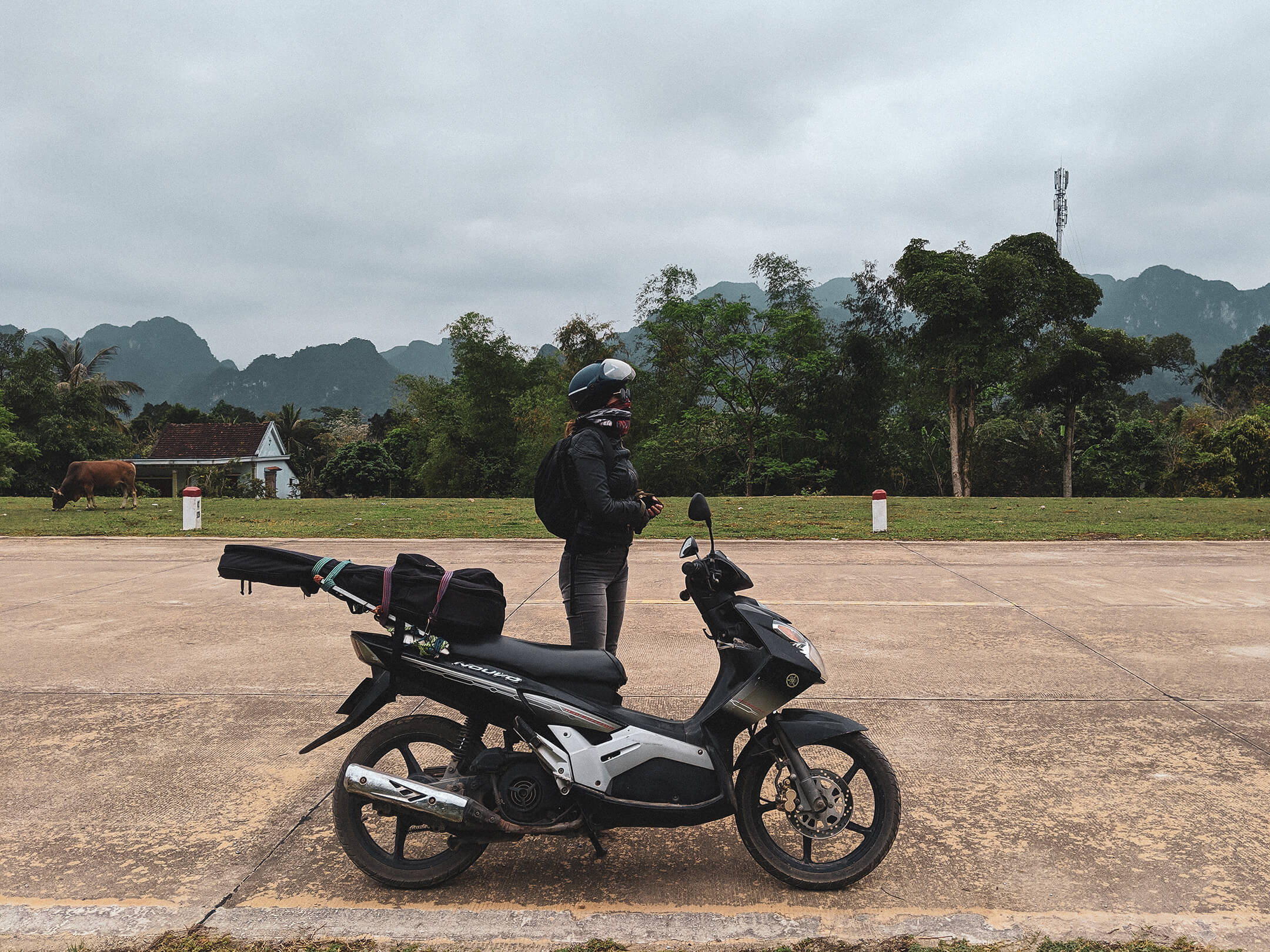
Anything bigger?
No. Big bikes are a rare sight in Vietnam. To buy anything bigger than 175cc you need to be in a club. Prices are often higher than in Europe due to import tax. Bringing your own bike is possible. One guy on a BMW GS with Romanian license plates passed us one day on the road.
Rent or buy?
Buy. Unless you stay less than a month. Sell it back when you leave. If you need to rent, you get the bike in Hanoi and drop it in Ho Chi Minh or vice versa.
When you buy a bike, the previous owner is supposed to give you it's blue card. Check if it's matching the license plate and keep it safe for when you will sell the bike. You will also need it if you drive through a border of a neighbouring country.
Buy and sell on this group or this group, in hostels, in the street, on Craiglist Be transparent with the issues you had and give relevant advice to the next owner, helping them to start this adventure. Solidarity is still a thing among travellers.
Gear up!
You can find all the gear you need in Vietnam. Just make sure you buy decent quality.
A helmet. I know., but many locals don't wear one. Anything is used as helmet, from colonial hats to a plastic cap with a hole for a pony tail. Get a proper helmet, preferably full face, and one that fits well. Most of the time you will only find XXL Sizes. A helmet that twists during a shock will cause additional damage to your cranium. A bowl helmet will overexpose your chin if your face was to hit the tarmac.
Sunglasses. Good sight will keep you alive on the road. Treat your eyes accordingly. Unprotected eyes is suicide. All the tiny flying shits will blind you, if not worse. Get protective and comfy sunglasses to get rid of the fine dust of the road. Also get a pair of transparent glasses. Some days are too dark for sunshades.
A jacket. Get a proper shield from the wind and sunburns. Do get a close cut, or the wind will make it twerk continuously.
A face mask, a scarf, a Keffiyeh or a Buff will protect your face from dust, insects, projectiles thrown by passing trucks, sunburn, horrible smells, diesel fumes, roadside fire smokes.
Jeans. Or any decent bottom layer. In case of crash, 1cm² of fabric lost is 1cm² of skin saved.
Gloves. If not to protect your hands from hitting the ground, protect them from getting hit by the sun.
Solid shoes. Feet are the first thing to hit the ground. Think about how much protection a flip flop offers.
The typical poncho cover. A Vietnam all-time classic. This colourful poncho will cover you, the whole bike, and everything on it.
Some tools. Fix a part that just fell on the road, fasten a loose mirror, fix the entire gearbox of your Win A Leathermann will do.
Bungee cord to secure all the stuff to your bike.
A basic first aid kit. At least enough to clean, rinse, sanitise and cover. In such places, even superficial wounds have a tendency to quickly turn bad. With heat, wound will be oozing a lot and stick to your clothes.

Taking care of your bike
Servicing your bike is the key to staying out of trouble. Check your ride between rides, see if everything is still holding in place, check the tires for damage, slashes and pressure, spot the missing bolts, fasten your mirrors, verify chain tension if you have one.
Basic maintenance:
- • Engine oil change every 1000 km max
- • Gearbox oil change every 2000 km max
- • Spark plugs every 4000 km
- • Brakes if they don't bite enough, chain tension, tire pressure, tire wear
You will find mechanics everywhere. In case of breakdown you probably won't have to push the bike. Vietnamese people have a technique to push you with their bike and they will never leave you stranded.
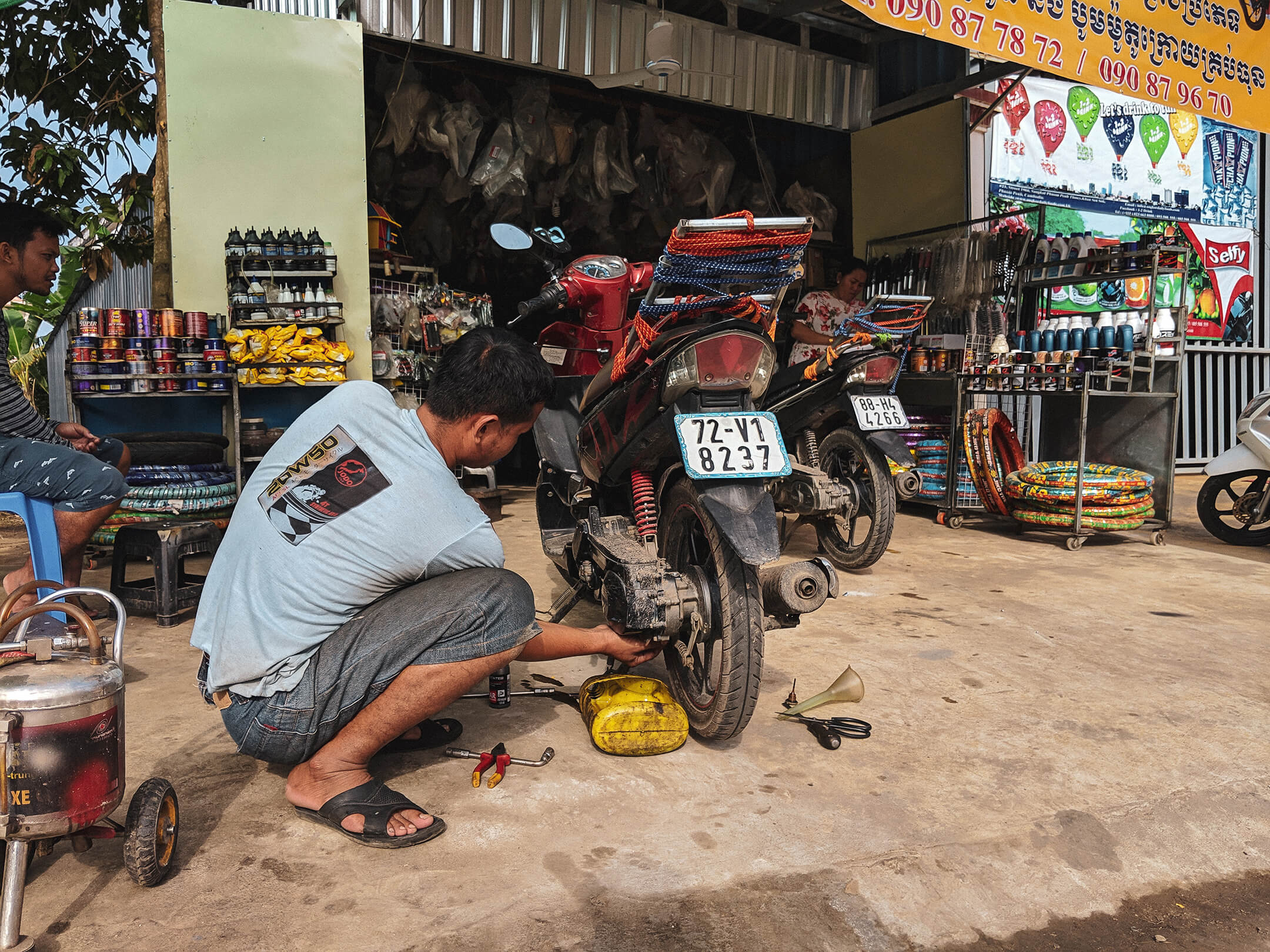
How much does it cost?
Depending on your standards, the cost will obviously vary. So let's focus only on what moving around costs. It also varies on the motorbike you choose and how many breakdowns you encounter, but here is an estimation based on our first 5000 km without breakdown.
- • Gas : 1,50€ / 100 km – ($1,70 – 60 miles)
- • Maintenance (oil changes, parts) : 30€ / 1000 km ($34 / 600 miles)
- • Parking : 2€(2.5$) / month
II. Living on the road
The traffic
Dense, loud and hectic. The traffic is something like 80% two-wheelers, 10% trucks and buses, 5% cars, 5% things of various nature (rototillers, kitchens on wheels ). The bigger the dumber (and thus dangerous).
The rules are very different. Red lights are optional, the biggest or fastest have priority, honking has many different meanings. Vietnamese traffic is organic. It’s flowing like a school of fish. You will rapidly find its dynamic and get used to it.
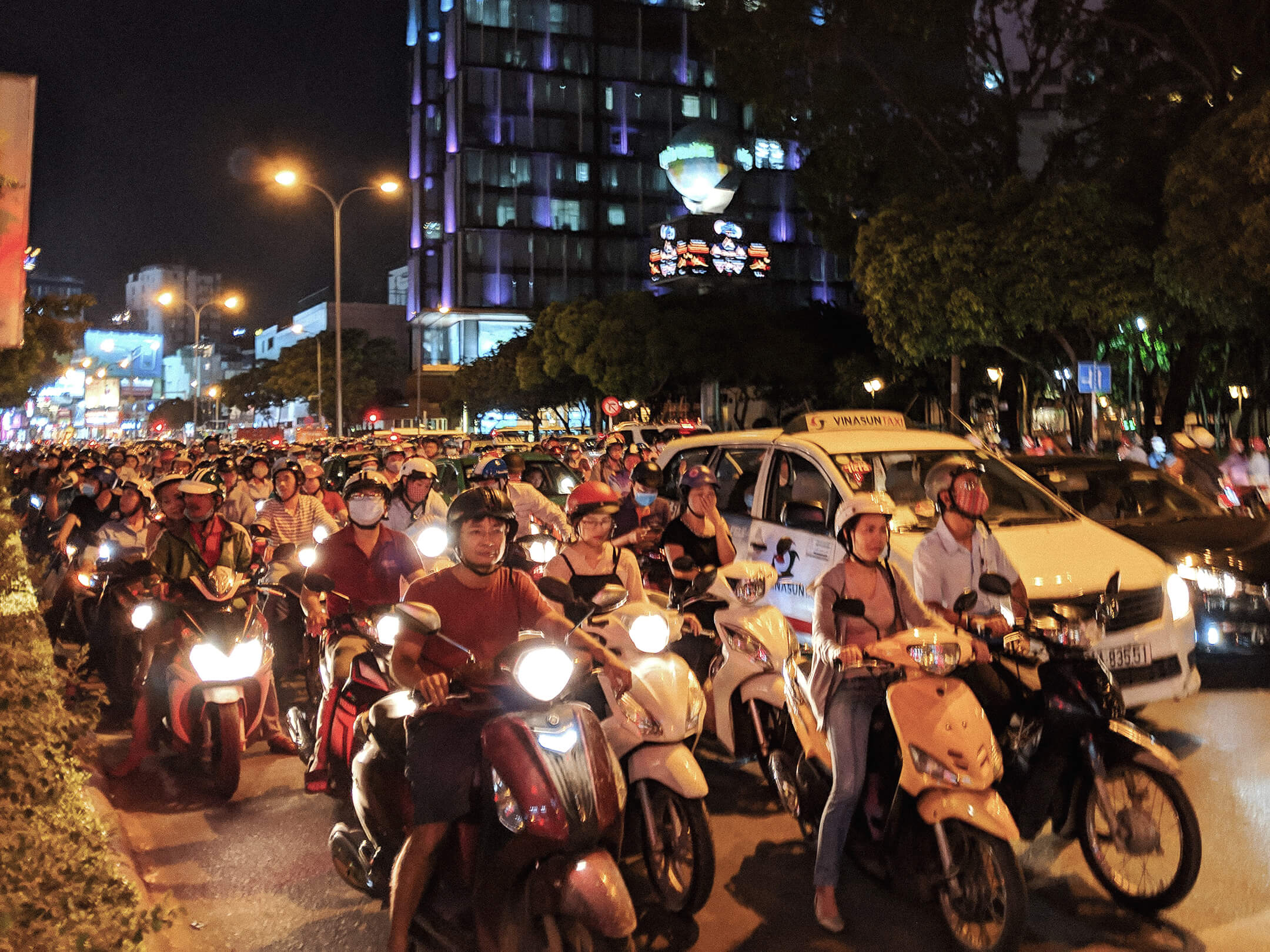
The state of the roads
The roads are basically terrible. In our experience they are slightly worse in the South than in the North. They have countless potholes, little to no roadside, and so many various obstacles, it feels like playing an arcade game. Except you can die. Bridges have deadly bumps, streets have a coating of mud, dust. Cattle live on it, chicken cross it for no reason, people dry shrimps or grain on it
In general, avoid big roads as much as possible. They are packed with trucks and busses, the landscape is boring. Highway 1 is not the best route from North to South. The real pleasure of motorbike is to go off the beaten path.
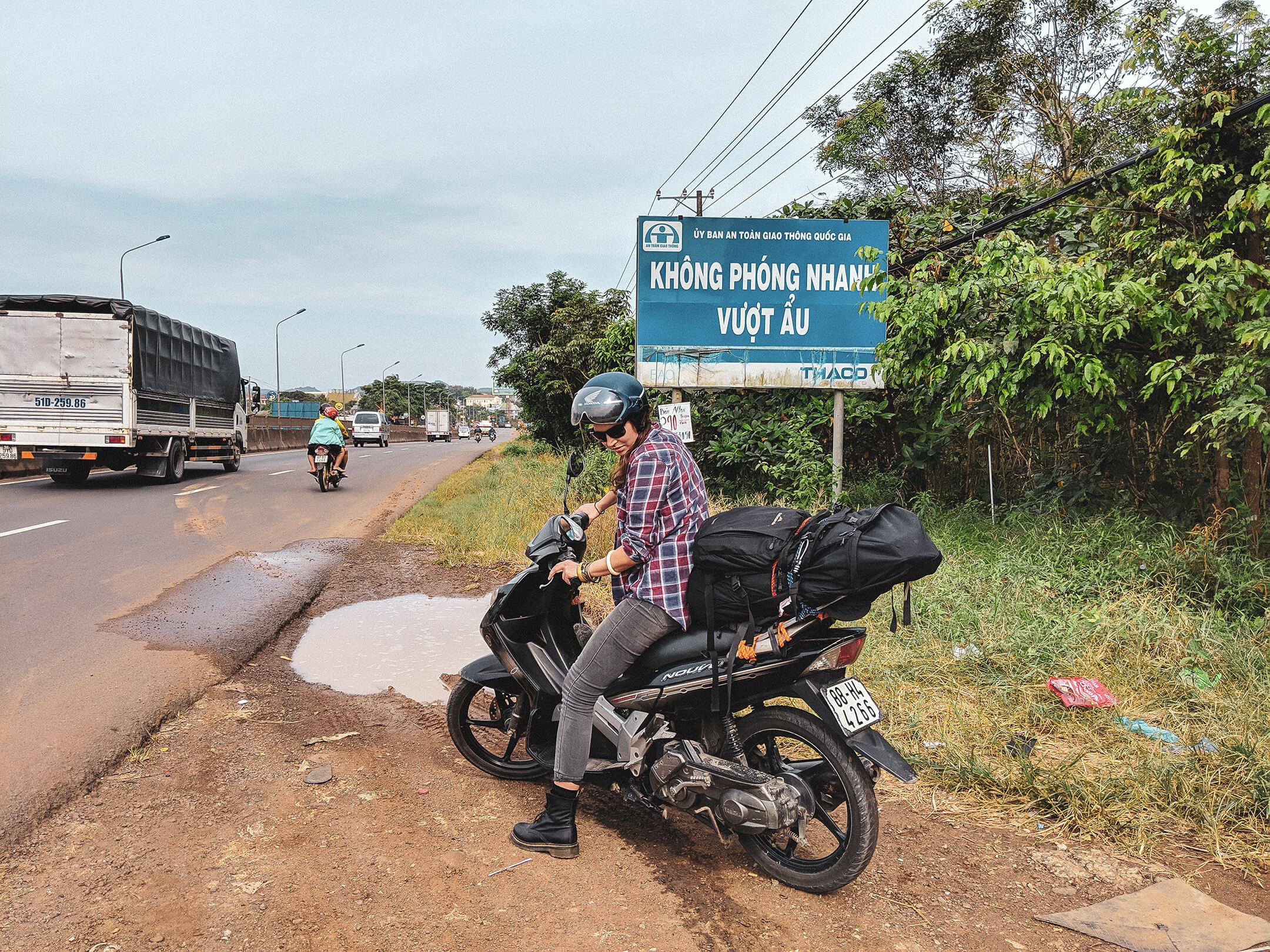
Where to sleep
Booking a place in advance is not the best solution, the journey sometimes take more time than planned, your bike can decide otherwise, you can be slowed down by heavy rains No worries, everywhere along the road, you will find cheap hotels, « Nha Nghi« . Don't expect high standards of cleanness, but for 6€ or $7 a room, most of the time you get hot water and a rock-hard bed. They are opened 24/7, and the owner often sleeps in the entrance.
Backpackers and hostels are located in all the cool locations. They are great hubs to meet all kind of travellers. Perfect for socialising, sharing tips and destinations. Often busy, sometimes you will get bed bugs, but it is a must for the traveler. Count between 4 and 8€, 5 to $10 for bunk bed.
Hotels are only in medium to big cities. Touristy destinations will have four seasons and other luxury chains, if that's your stuff.
Airb'n'b is popular in bigger cities.
Couchsurfing has more than 100,000 hosts in Vietnam.
I believe it is possible to camp in a tent or a hammock, but often, the road is a continuous stream of houses. I'm not sure about how the locals will see this.
How to eat
You cannot really count on preparing your own food, sandwiches or lunchbox. It is often hard to find basic ingredients like vegetables or bread. There is little to no supermarket and the rare shops only sell toxic processed foods and sweet snacks. Everything is sugar overloaded. Cheese crackers are sweet, potato chips are sweet, everything is sugar coated.
Vietnam food culture is strong and vibrant, but once you leave big cities the story is different. Nonetheless, all along the road you will find cheap food, restaurants, motorbike kitchens If you are vegetarian, almost any place will cook something vegetarian if you ask « ăn chay ». Fried rice with vegetables, noodles, eggs, greens We never had any food poisoning in Vietnam, but perhaps it is because we do not eat fish or meat, ingredients that often cause exploding diarrhoea when they stay all day in the sun.
Fill your tank
You can refill your tank anywhere. There are petrol stations are everywhere, even in remote areas. All small roadside shops will have gas in soda bottles. You will rarely drive 5 km without seeing a source of gas.
We have heard rumours about bad quality gas, but never encountered a case.
The price is about 20 000 Dong (0.80€) a litre — $3,5 a gallon.
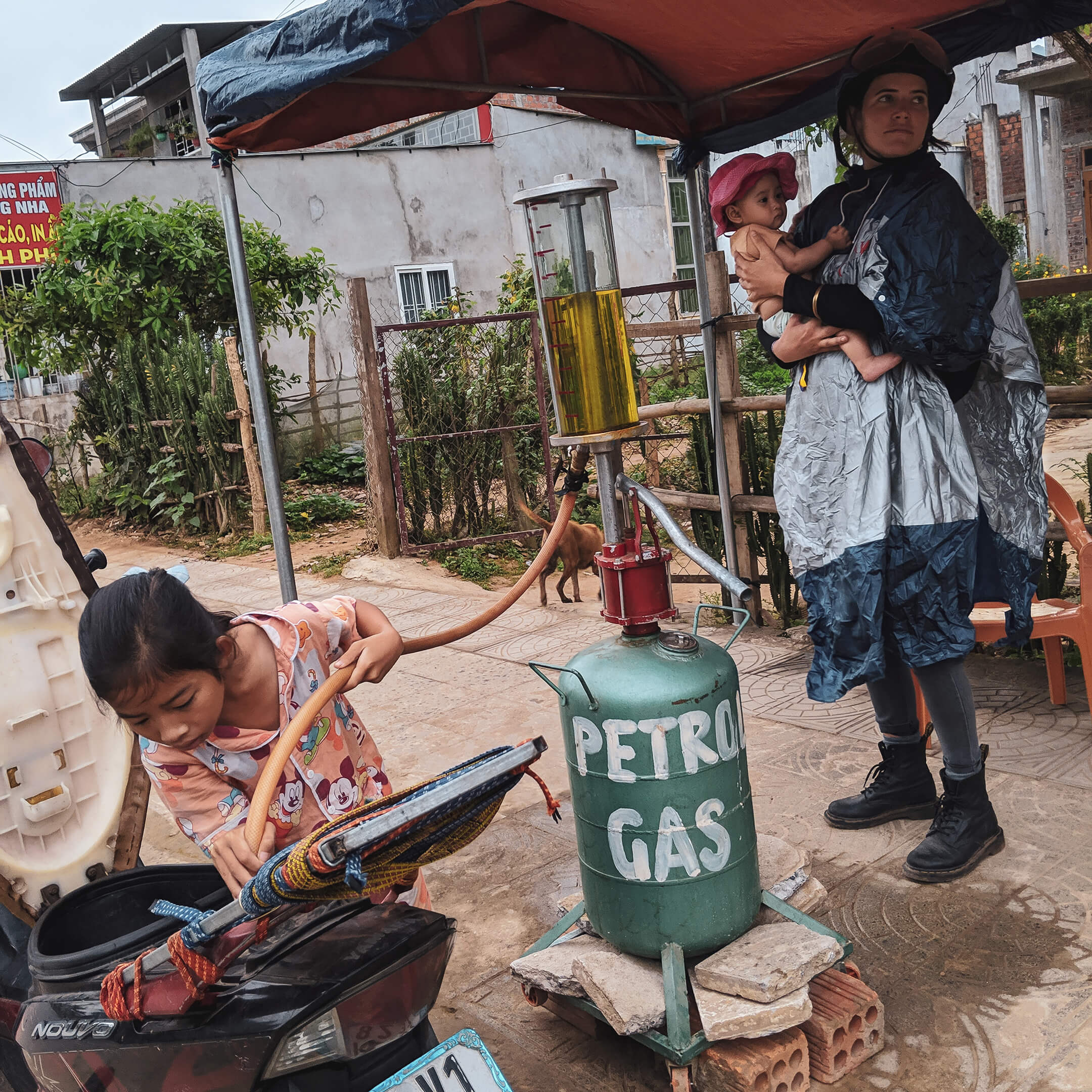
Navigation tips
Google maps has offline routing. Just make sure you save the map in advance. There is also a motorbike mode for South East Asia.
Maps.me is a good backup solution for offline maps of a whole country, but also has nice features for points of interest.
We do not have special recommendations on where to go or what route to take in this article. Drive your own way according to what you want to see, ask other travellers, explore, try new things.
200km / 125 miles a day is a good limit, anything longer gets boring and uncomfortable.
Weather precautions
The North is subject to winter, it can be cold, foggy and rainy, the South is hot all year. The best time to visit Vietnam is from November to April, the climate will be drier. For the Central Vietnam, wait until February to avoid the monsoon. Beware of the peak tourist season surrounding the Vietnamese New Year, around the end of January.
Beware of surprise showers. We drove only during the dry season, and even there we were rinsed by showers. We do not recommend driving in the rain, the drops are huge and hit the face like hell, the windshield of the helmet is unusable, water gets everywhere and transforms the shoes into bathtubs.

III. Good to know
The police
Traffic police, dressed in sand uniforms, are a pain in the ass for any driver. Locals call them "yellow dogs" although I find it offensive. For dogs. It makes sense that they will take advantage of you, especially if you are driving illegally. Their power of nuisance is very high, they can impede your bike for a month, even jail you over « illegal parking ».
Avoid Mũi Né. The police there is a wild bunch specialised in bike racket. We haven't got any trouble in Vietnam except in Ho Chi Minh, a fat cop stole 2 millions dongs (75€ – $85) from me. It represents about 30% of the average local salary, but judging from how dodgy the cop was, we doubt this money benefited the people of Vietnam.
To deter them, have an action camera on your helmet, pretend you don't speak English (any other strategy to waste their time until they give up), or be a woman (it seem women are invisible to them). They did not even look or talked at Margaux, who was driving on my side while they stopped me and brought me to an ATM.
In case of accident
Despite the density of traffic, accidents are relatively rare. Except for a few low-speed acrobatics and a guy who slid next to me, we did not witness any serious accidents.
Things are settled on the spot. Police arrives and decide who has to pay what. If you seriously hurt someone, the penalty is 10 years in prison.
Emergency services are not on top, often people get to the hospital on their own means or with a taxi. My advice is therefore not to have an accident.
A parking religion
Parking your bike is a science in Vietnam. The rules are quite vague and differ from Europe. Often you find your ride parked somewhere else, stored differently, turned around or even locked. They cannot help but readjust motorcycles, park them as close as possible to each other even when there are miles of space.
Sometimes you think you can park your bike, but the second you deploy the kick-stand you get yelled at. Vietnamese people are relaxed and remain impassive in the chaos of traffic, but parking your bike can trigger strong reactions. Parking in front of a shop and getting into the one next door is a way to start a fight.
Everywhere, dudes in uniform have the task of parking and watching two-wheelers. This service, mandatory but welcome, is usually free. Sometimes you will be asked between 5,000 and 10,000 Dongs (0,20 € – 0,40 €).
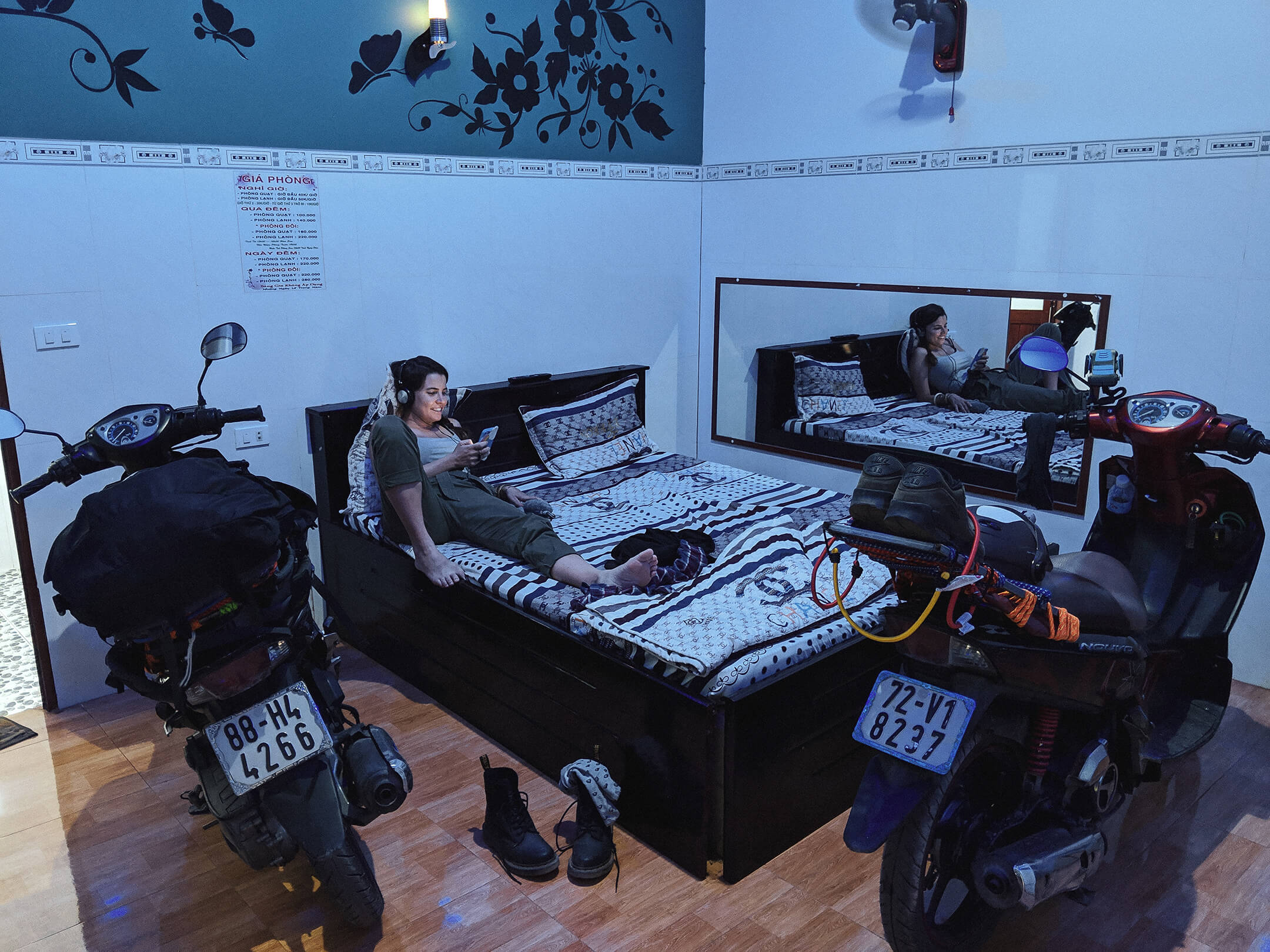
The risk of theft
Like everywhere in the world, it can happen. We met some unfortunate people who lost their rides. The poor quality of the bikes makes them quite simple to steal. With the keys of our scooters, we could start any other Yamaha.
It has happened to me several times to forget the key on the ignition and to always find my scooter when I came back. Just be careful where you park, and if you still worry, buy a lock.
The Dark side of the road
On top of possibly getting victimised by pigs, there is another concern. We have heard stories of locals deliberately causing accidents to get insurance money. In the event of an accident, illegally driving travellers are liable by default and therefore have to pay. It happened that Westerners got driven over and be sent to prison. As if the whole thing was not funky enough, they will have to compensate the shameless individual who mutilated them.
During our first expedition on Vietnamese roads, a biker lost his balance for no apparent reason at my level, hitting me slightly and barely missing me from eating dust. The man and his bike slipped for a few meters, luckily without serious damage. Impossible to talk to him. Instantly, four passers-by jumped on him, two of them had put him up, two others were checking on the bike, then they all disappeared. The dense traffic had closed behind them, leaving only Margaux and me disconcerted. Sometimes the nights of full moon I still wonder about how and why this guy fell like that.
You will often see white drawings on the road, some with little ponds of dried blood. They will remind you that the road can be merciless. So stay sharp, stay hydrated, tell your mom you love her.
Often on the road you will see white markings, sometimes with small puddles of dried blood and oil. They will remind you that the road can be merciless. So stay sharp, stay hydrated, tell your mom you love her.
Safe journey, you crazy numb-nuts!
This article is a reflection of our personal experience, time spent with locals, other travellers, as well as some research.
